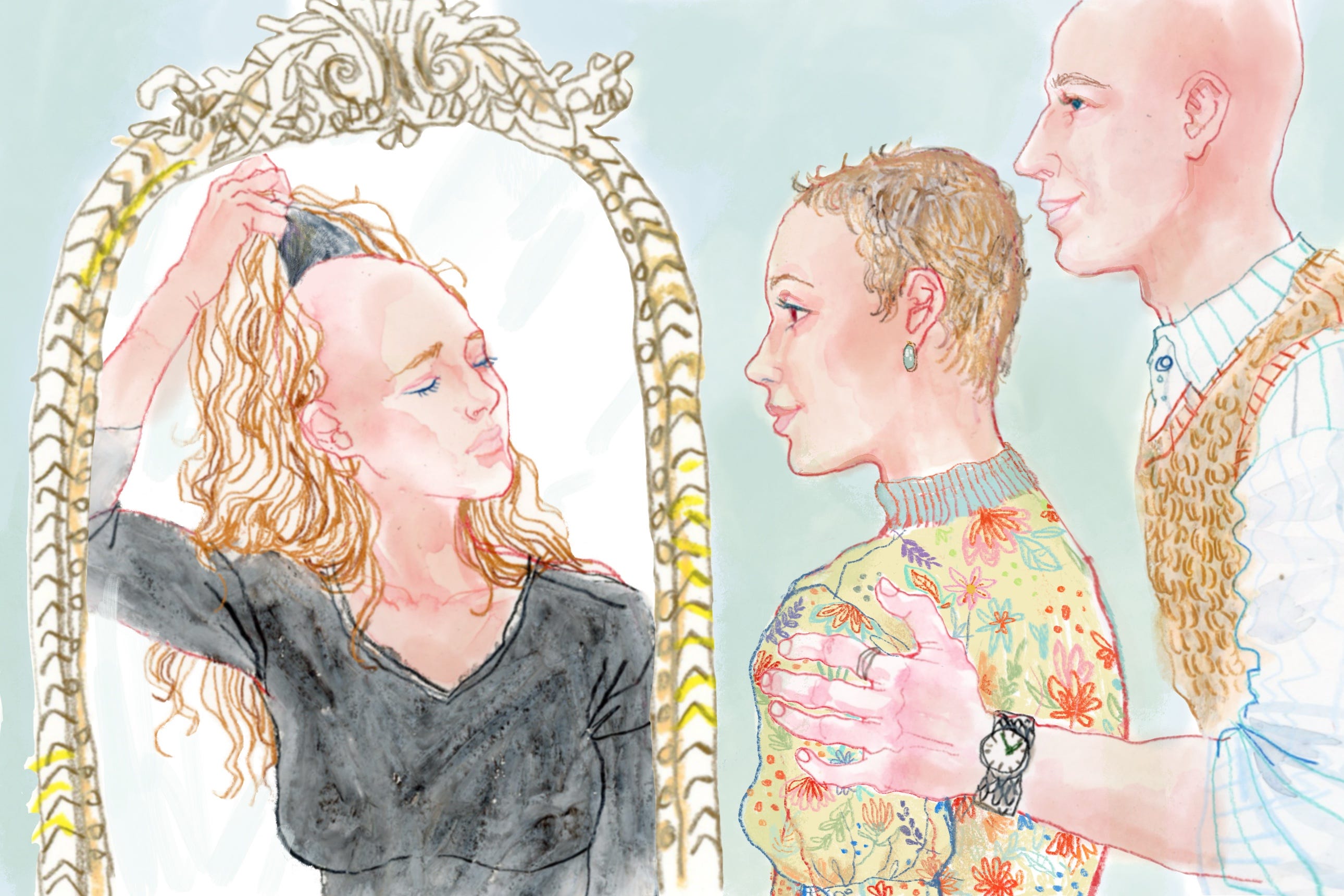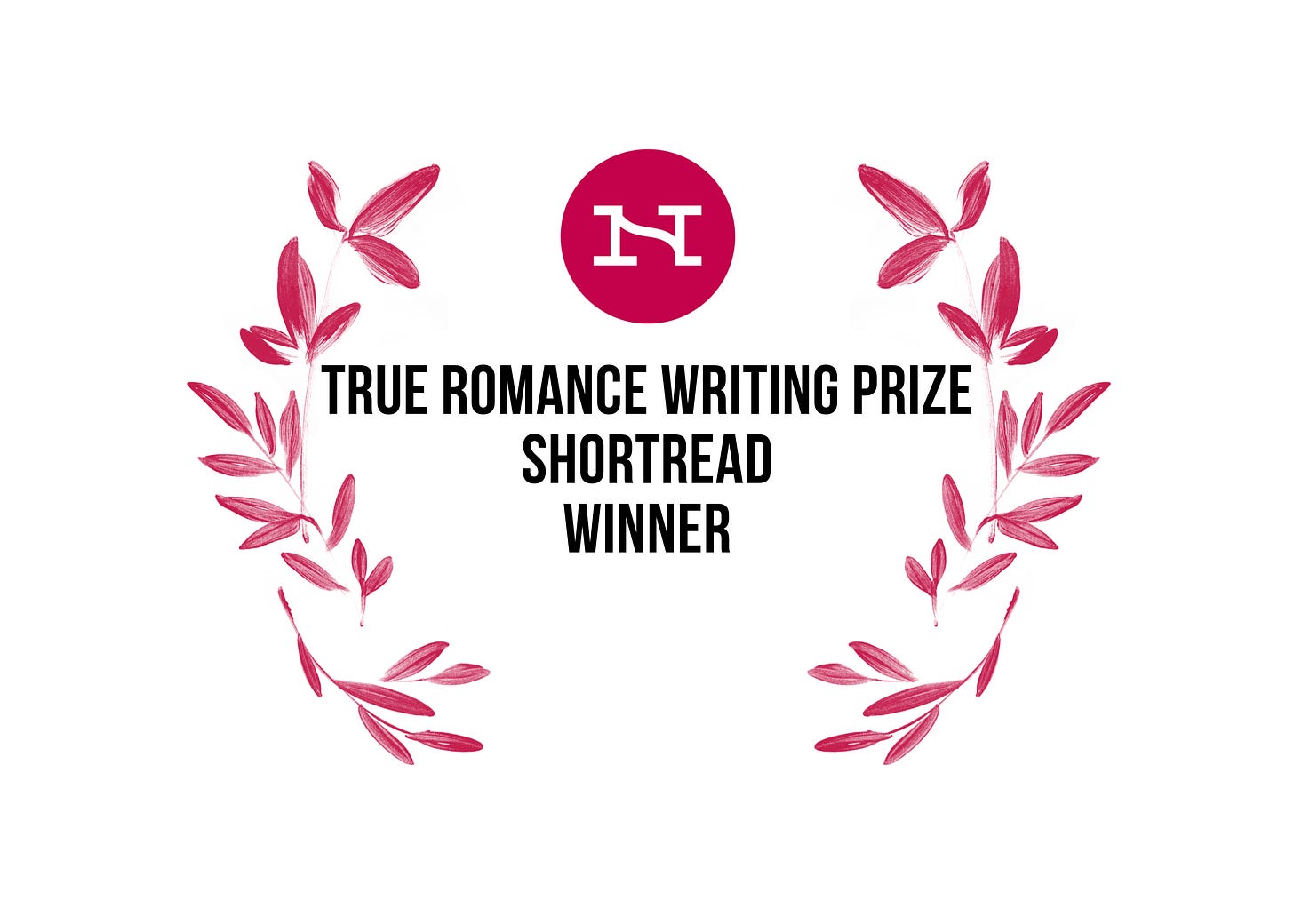The Unexpected Challenges of Dating After Cancer
The chemo had miraculously worked, but Maggie Hart wanted to make sure 'this whole cancer thing' had not rendered her 'sexless and unlovable.' There was just one thing she needed to figure out first.
It was such a joy to collaborate with Emma Roberts, Karah Preiss and the whole Belletrist team on the True Romance Writing Prize this year. After announcing the winners a few weeks ago, we’re excited to finally share the first piece of the bunch, the grand prize–winning essay in the shortread category, which comes to us from Maggie Hart. Maggie opened up a bit about writing this piece and others like it: “After I completed my chemo treatments, I felt awkward and ugly in my baldness, convinced I’d never be able to exist normally again, much less date. But finding small moments of humor and lightness helped me get through. I think lots of people view serious illness as something that only happens later in life, which just isn’t true — so I like sharing my stories about navigating the weirdness of cancer survival and young adulthood all at once.” Congratulations again, Maggie! And readers — you’re in for a treat.
“I’m sorry,” I said to Nick, who stood staring at me in the dim light, his bare chest rising and falling with quickened breaths, his lips swollen from my kissing them. “It’s just that…well, I’ve been really racking my brain here, and I just don’t think there’s a sexy way to do this.”
My fingers lingered at my forehead, on my hairline. My wig gripped my scalp like a barnacle on a boat, the scratchy fibers relentlessly digging into my skin, one of many small, manageable pains I had in those days. It had to come off for what was about to happen, I knew that. There was really no way around it. Leaving it on was impossible — I had a profoundly humbling vision of the wig abandoning ship mid-action, slipping loose and tumbling onto the floor in a sad, sweaty heap. It had also been quite an investment — although I still do not understand why a bunch of fake hair costs multiple hundreds of dollars — so I didn’t want it to get hopelessly matted. And what if, in the throes of passion, he forgot that the hair was fake and tried to pull it…
No. No! Obviously, it had to come off. But how, exactly? I wished he’d look away, spare me, if only partially, from the humiliation of my baldification, the world’s least seductive strip tease.
Nick smiled at me encouragingly. He was kind and tattooed and had long dark hair that was beginning to streak with gray. I’d never been with a man who had hair longer than mine, although, that winter, any man with any hair at all had hair longer than mine.
Four months after my last round of chemotherapy, I decided that it was time I put myself out there, that I date. Why not? The chemo had, miraculously, worked. My blood counts were relatively normal, I hadn’t needed a platelet transfusion in weeks and my oncologists gave me the all-clear, so it was time that I shifted my attention away from my no-longer-imminent death to something much more invigorating: the pursuit of reassurance. I needed to know that my body worked, that I still knew how to have a conversation that was not about being sick, that this whole cancer thing had not rendered me sexless and unlovable at just 25 years old. So, I went where every woman in her 20s goes when she needs reassurance: the apps.
But what to do about the baldness, the wig? It was a predicament. I wanted pictures on my profile from when I’d traveled, and pictures of myself with friends, to demonstrate that I was compellingly adventurous and companionable. I wanted to encourage the man-swipers to imagine me as their fun, hot, cool girlfriend, but those pictures were from months ago, and I had long, wavy hair in all of them. That hair was gone — it had been buzzed off my head in a beige hospital room, the strands stuffed into a trash can amongst latex gloves, tiny plastic pill cups and bloody tissues from my never-ending nosebleeds. Eventually, I decided to put it all out there: I uploaded a few BC (Before Cancer) pictures along with some newer selfies of me in wigs. “I’m a recent cancer survivor,” I wrote in my bio, “so any hair you see is either gone or fake.” That, evidently, had not been an issue for Nick. After a few successful dates, I agreed to go over to his place.
I took a deep breath, my eyes closed. “It’s OK,” Nick said. My fingers were still hovering around the wig’s edge. He put his hands on the sides of my face, rubbing my cheeks with his thumbs. His palms were warm.
“OK,” I said.
“You’re sexy,” he said, before stepping away and plopping onto the edge of his bed. “So, it doesn’t really matter if taking off the wig is sexy or not.”
“OK,” I repeated. I wasn’t fully convinced, but he was looking at me the way men had looked at me before I got sick, so I believed he was. I could work with that.
I reached up and hooked my thumbs under the elastic gripping my forehead. He still didn’t look away, so I closed my eyes as I started to tug. Slowly, I peeled off the wig, feeling the chill of the air on my clammy scalp as it was exposed, inch-by-excrutiating-inch. When I opened my eyes, he was standing again, smiling at me.
“Still sexy,” he said.
“I feel like a plucked chicken,” I replied.
He stepped closer and kissed the top of my head, then my nose, my mouth. I clutched the wig limply between us, a crumpled and ridiculous thing, still warm from my skin. “Let’s go to bed,” he whispered into my neck, and I nodded. As he tugged off his pants, I placed the wig, gently, on the top of his dresser.
Nick was wonderful and considerate, but he was not The One. I said goodbye to him a few weeks later, and months after that, I said goodbye to the wig, too. I stopped wearing it when I moved to Oklahoma for graduate school. The curls sprouting from my head were long enough that it was getting more and more challenging to stuff them underneath wig caps, and I no longer looked like a Very Sick Person, just a “normal” person with short hair. Impossibly, I started to feel OK without the wig, pretty even, though sometimes my hands would still grasp at hair that was no longer there.
My curls looked cute for my first date with Michael, a walking beam of sunlight, an endless cache of terrible jokes, the person who ended up being the (bald) love of my life. We sat next to each other on a sofa in a café, two strangers, and talked about all the regular first-date things: family, jobs, how we’d both ended up in a state we didn’t like. As time passed, we also began to talk about baldness — how strange people are about it, the vulnerability of baring your entire head to the world. How cold our heads can get.
“You wouldn’t believe how many people told me I looked better before,” I said to him. “And it’s like…obviously, but I had cancer, you know?”
“I would believe it, actually,” he said. “People have told me the same thing. And mine’s not coming back.”
“Well, I think the bald thing works for you,” I said. He looked at me, with gorgeous, glittery eyes, and smiled.
“You think so?”
“I do.”
Maggie Hart is a writer, leukemia survivor and traveler from Colorado. She’s currently pursuing a master’s degree in rhetoric and writing studies at the University of Oklahoma. Her writing has been published in The Blood Project, Mud Season Review, December Magazine, and The Audacity, among others. You can find her on Instagram @maggie.hart.
Sang Pak is an illustrator based in Philadelphia, working with magazines, newspapers and commercial clients. She works primarily with traditional media, including colored pencil, oil pastel and watercolor.





I loved reading this. Heartfelt and beautiful.
I, too, and a former chemo plucked-chicken. This piece was relatable and relevant. I felt defeminized and sexless. Thank God it gets better. Not entirely perfect, but better.